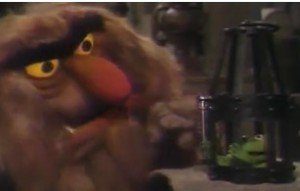The Frog Prince
I can’t lie. Ever since I began this project, The Frog Prince is one of the Muppet specials I’ve been most looking forward to revisiting. As a little kid, I actually owned the record (yup, they had those things back then), which I believe had either the audio from the entire show or very close to it, and I would listen to it over and over. Later on, I finally recorded the special when it aired on the Disney Channel and watched that over and over, to the point that even though it’s probably been 25 years now since the last time I’d seen or listened to it, I remembered almost the entire thing vividly. And I don’t just mean situations but lines, entire exchanges, and complete songs, lyrics and all.
The second in the Tales from Muppetland fractured fairy tale trilogy, The Frog Prince–which Jim directed in late March of 1971 and which aired on May 11th of that year–is also my favorite of the three (the others being Hey Cinderella! and The Muppet Musicians of Bremen, the latter of which is still upcoming in our journey), and while there are certainly sentimental reasons on my part, I also think that, on its own, it’s a fantastic hour of television. It isn’t as snarky, meta, and anachronistic as Hey Cinderella! and so perhaps is actually a little further in that respect from later Muppet productions. It does, however, have recognizable Muppety heart in abundance and manages in its own surprisingly gentle, sincere way to weave in some significantly clever fairy tale twists and some hilarious gags.
And unlike the previous special, The Great Santa Claus Switch, the emotions all feel earned, the characters are active, the story is engaging and doesn’t feel stretched out to fill the hour, and the precise way they arrive at the ending can’t be seen from a mile away. It also has an absolutely lovely score by Joe Raposo with some of the most memorable songs in the Muppet canon, if I do say so myself (even if today most people don’t know them), making it, in my humble opinion, the first great Muppet musical.
Like The Great Santa Claus Switch before it, it also features a number of significant milestones in Muppet history, although not as many, being a far more scaled-back production. Rather than bursting to the seams with brand-new Muppets as Switch was, The Frog Prince instead has a relative few, most of whom were drawn from Henson Associates’ already-established repertoire. It makes use of King Goshposh–here playing King Rupert II–and Taminella from Tales of the Tinkerdee, Featherstone from Hey Cinderella!, and Kermit, again taking on a sort of narrator/Greek chorus role. To supplement the cast, they built a bunch of additional frogs (many of whom show up as Kermit’s frog friends in later productions) to frolic in the swamp and to eventually help save the day, as well as a number of human Muppet subjects to stand in the courtyard and respond to the king’s decrees, but these two sets of groups only appear in a limited capacity.
Those aren’t the only new players, however. The special not only features but centers on the very first appearance of Jerry Nelson’s Robin, here taking the protagonist role, the prince, Sir Robin the Brave, who was cursed by the dastardly Taminella into the form of a tiny frog! In later productions, he would become Kermit’s nephew, Robin, certainly in no small part thanks to their fantastic chemistry here. Kermit really takes the little guy under his flipper from the moment they meet, acting as his froggy mentor of sorts (although Robin is an adult prince, it’s difficult for Kermit and us to not see him as a little kid until his transformation back into his original form), so this paternal dynamic led naturally to their later familial relationship.
Furthermore, just as in Tales of the Tinkerdee, Taminella has an ogre minion here, except instead of being played by Jim Henson and his legs, he is Sweetums, in his first appearance! And unlike proto-Gonzo in Switch, Sweetums has the same name and look we know from the very beginning. The only major difference is his voice, which is here performed by Carl Banas (meanwhile, the man inside the suit was Jerry Nelson, who worked another full-body Muppet, Thog, in the previous special) but would later be taken on by Richard Hunt, who really made the character his own.
But just as Kermit and Robin’s relationship is established here, so is Robin and Sweetums’. Although he is Sweetums’ prisoner and the ogre does plan on eating him, Robin lulls him to sleep with a gentle lullaby, which lays the groundwork for the Muppets’ propensity for pairing the two together, probably most notably in their sweet duet of “Two Lost Souls” from the musical, Damn Yankees, on The Muppet Show. This was likely due both to their shared origins, as well as because the contrast between their sizes and visages make for an amusing and surprising juxtaposition, particularly when the two are cast in the role of friends.
Also, while this may have been a simpler production from Switch in some respects, it’s still an extremely impressive accomplishment from a technical perspective. Most of the elaborate sets–which include a fairy tale castle, with various rooms, a dining area, an outdoor courtyard, and dungeon, the pond area outside the castle, and a dark, foggy forest–were actually elevated on struts so that the puppet performers could stand underneath. Meanwhile, Kermit’s appearances in the pond would seem to have required some sort of contraption that allowed Jim to stick his hand up through the water to perform him from under there as Kermit, who, at certain points, both swims and speaks to us while almost fully submerged. Now, during the classic opening rendition of “Rainbow Connection” in The Muppet Movie, Jim himself was actually entirely submerged in a tiny water tank with scuba gear for hours on end. I don’t believe that’s the case here, but it is the first time, as far as I know, that Jim puppeteered Kermit in actual water, and so it sets the stage for that most famous of Muppet moments in their first film.
Additionally, as in The Great Santa Claus Switch, there are very few humans here. There’s the lovely Princess Melora (played by Trudy Young, who had a small role in The Cube) who, like Robin, was also placed under a wicked curse by Taminella, and the human prince version of Robin (Gordon Thomson), the latter of whom only appears for a few scant seconds of screen time, all told. Everyone else is a puppet, although all of the human Muppet characters–King Rupert, Featherstone, and Taminella, are full-body puppets like Sweetums–allowing them to stand at a similar height to Melora (Featherstone’s skinny, floppy little legs are particularly amusing).
But moving on to the plot itself, The Frog Prince bears very little in common with the Grimm fairy tale from which it derives its name other than the basic premise of a princess dropping her golden ball in a well, where it’s fetched by a frog who asks her if he she can bring him to the palace in exchange for the service, which she agrees to, later kissing him (or, as in the original version, throwing him against a wall!) and breaking an enchantment that had been cast upon him, revealing a handsome prince. In the original story, however, the princess is a rather beastly brat who, at multiple points, tries to renege on her deal with the frog. All in all, it’s a moralistic story that teaches both not to judge a book by its cover and to generally not be an awful person.
The Muppet version, however, fleshes out the tale by–as I mentioned before–making the princess a kind girl who was also cursed by the same witch who cursed the frog, providing them with a more natural bond. After retrieving her golden ball, Robin doesn’t tell her that he’s actually a prince, but he does prove to be the only person who can understand what she says, for you see, the spell that Taminella has placed on Melora renders her speech incomprehensible to everyone around her. But part of the joke comes from the fact that, in actuality, in most cases, all that the curse does is to cause her to flip first letters of adjacent words around, such as in her truly beautiful song, “N’I’m Einteen,” which includes a line in which she sings that she’s now a “gib birl, a loman, a wady, say they…”
Pages: 1 2



